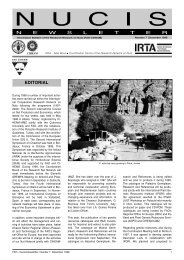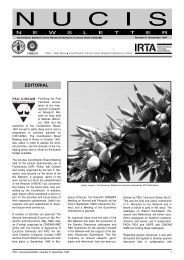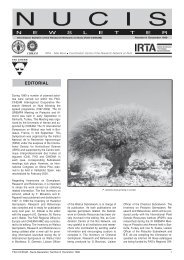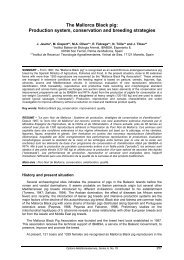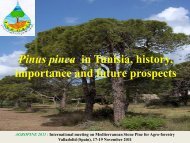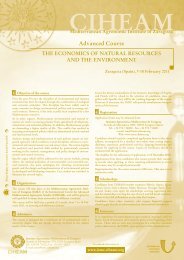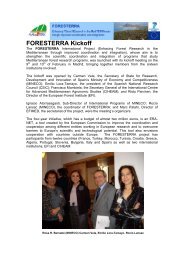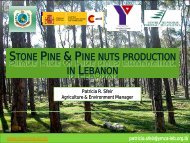Table 1. Pistachio production in Tunisia (2002).Surface Number Yield Yield Density(ha) of trees (t) (kg/tree) (trees/ha)Irrigated crop 1.065 135.500 148,3 1,1 125Rainfed crop 41.983 2.888.618 1.029,5 0,4 70(Source: DGPA, 2002)Figure 2. Repartition of Pistachio growing area in TunisiaFigure 1. Geographical distribution of Tunisianpistachio growing area706050% of total area% of total productioncenter and the south of the country (Fig.1). Gafsa, Sidi Bouzid, Kasserine andSfax are the most important producing regionswith respectively 19.800 ha, 9.188ha, 7.668 ha and 3.290 ha.Despite this acreage increase the productionis still very weak reaching only1.170 t with important differences betweenirrigated and rainfed orchard and alsoregions (table 1). The north region representsless than 1% of the growing surfaceproducing more than 16% of the nationalyield (fig. 2).To understand this weak yield and characterizethe current situation of pistachiocrop in Tunisia, a survey was carried outin the important Tunisian pistachio growingzones (Ghrab et al., 2002b). Themost important observations were:• Inappropriate distribution of male andfemale trees on the orchard. Different ratiosof male to female varying from 2% to90% were observed reducing the profitabilityof the orchard.• Inadequate planted material that is supposedto be ‘Mateur’ as female and malesA40 and A25 cultivars. However the observationsmade revealed significant phenotypicdifferences between trees.• A shift of the flowering periods betweenA25 and A40 male cultivars and ‘Mateur’inducing an inefficient pollination. Thosecultivars were selected on the north ofthe country for their production, qualityand overlapping flowering period howeverunder the central and southern climaticconditions the flowering period of themale cultivars does not overlap with theblooming period of Mateur.• Since pistachio tree needs more thanfive years to bear under the central andsouthern semi-arid conditions, some growersopted for other species and quittheir orchards without any management.• For some pistachio growers, managementoperations such as fertilization, pruningand pest and disease control were%403020100Northignored and considered without any benefitfor this crop.CULTIVARS AND ROOTSTOCKSThe most commonly cultivated variety inTunisia is ‘Mateur’ (Fig. 3), selected in theNorth as well as two corresponding pollinatorsA40 and A25 (Mlika, 1980). Almostall the development of the pistachio industryin Tunisia is based on this cultivar.Few other local varieties are cultivated insome specific localities from which it tookits names as ‘Meknassy’ cultivars in the regionof Meknassy (Sidi Bouzid), ‘El Guettar’from the region of El Guettar (Gafsa) and‘Nouri’ and ‘Thyna’ from Sfax region.As rootstock, P. vera is almost the onlyused by growers for its good germinationrate. P. atlantica and P. terebinthus, inspite of their good characteristics asrootstock are barely used because oftheir seed germination difficulty.CULTURAL CONSIDERATIONPropagationT-budding is the most common propagationmethod. The budding is performed inJuly at the nursery on seedling of P. vera.The following winter trees are planted inthe orchard.PruningThe training system used for pistachio isusually the open vase, however a lot oforchards were grown without any training.CentreGrowing AreaSouthThe annual pruning is also rarely made. Ifit is made it is mainly to remove dried, diseased,infected, pest damaged, andnon-fruiting old shoots.PollinationPistachio trees are dioecious, with maleand female flowers borne on separatetrees. The designed orchard should ensurean adequate pollination. Male trees areoften planted in the center of a 3m x 3msquare of females, yielding an 8:1 ratio(Jacquy, 1973). Additional male trees aresometimes planted in border rows. Naturally,wind transports pollen from maleflowers to female flowers. Efficient pollinationwas assured when the floweringperiods of males is long enough to overlapwith the female flowering. But underTunisian conditions, a high percent ofblack fruit is obtained, and natural windpollination is proved inefficient and artificialpollination was widely adopted(Mlika, 1974). The male panicle is harvestedand kept on a dry, shaded place.The pollen is collected and mixed withtalc (1/9 ratio) and sprayed on the femalepanicle early in the morning. Three to foursprays are made during the female floweringperiod to insure a good pollinationrate.Pest and diseasePest and disease decrease quality andquantity of pistachio crop through their directand indirect damages. Few important20 FAO-CIHEAM - Nucis-Newsletter, Number 12 <strong>September</strong> 2004
Figure 3. Tree and nuts of ‘Mateur’ cultivar,Mateur, Tunisiapests and diseases are observed for theTunisian pistachio orchards. Eurytomaplotnikovi and Megastigmus pistaciae:the most pistachio fruit damaging wasps.They damage pistachio by feeding onnuts resulting in fruit blackness and drop.The most important disease is the leafspots, which caused a pre-matured leafing.Fertilization and irrigationFew growers fertilize and irrigate their orchardsdespite that the important growingareas are located on semi-arid zones withannual rainfall ranging from 150 mm to300 mm. This could explain the low yieldobtained. Some growers irrigate their orchardsonly during the first years of plantation.HarvestingIn Tunisia all orchards are hand harvestedfrom late August to early October dependingon the climate and the region.CONCLUSIONIn Tunisia the culture of pistachio existssince antiquity. But, in spite of this, its developmentstarted only thirty years agowith large planting programmes. However,its production is still low and researchwork should be done for pistachioproduction improvement. Based on thisstatement, different researches on pistachioare going on in Tunisia such as:• Developing micropropagation techniquesfor Pistacia species for rootstocksuse (Chelli Chaabouni and Gouta, 2002;Chelli Chaabouni and Drira, 2002).• Selection of male trees for Mateur cultivarunder the central and southern conditions(Ghrab et al., 2002a).• Survey and characterization and conservationof Tunisian pistachio germplasm.• Evaluation of introduced cultivars underTunisian conditions.AKNOWLEDGMENTSI wish to thank Mrs. Cherif R., Rhouma A.and Triki M. A. for their great help to completethe pest and disease part.REFERENCESChelli Chaabouni and Drira N., 2002.Culture Media and Hormone Effects onthe micro-propagation of two Pistachiospecies. III Inter. Symposium on Pistachiosand Almonds. Acta Hort., 591:395-398.Chelli Chaabouni and Gouta H., 2002.Effect of chemical scarification and giberellicacid on in vitro germination ofPistacia atlantica seeds. III Inter. Symposiumon Pistachios and Almonds.Acta Hort., 591: 73-76.Ghrab M., Ben Mimoun M., Triki H. andGouta H., 2002a. Evaluation of the performancesof seventeen male pistachiotreespecimens. III Inter. Symposium onPistachios and Almonds. Acta Hort.,591: 473-478.Ghrab M., Gouta H., Triki H., Jabeur M.,and Laroussi K., 2002b. L’amandier etle pistachier en Tunisie centrale: étatactuel et perspectives d’amélioration.Document technique, Institut de l’Olivier,1/2002, 16p.Jacquy R., 1973. La culture de pistachieren Tunisie. FAO, 97p.Mlika M., 1974. Contribution à l’étudede la pollinisation chez le pistachier.DEA Faculté des Sciences de Tunisie.Mlika M., 1980. Contribution à l’étudedu pistachier en Tunisie : choix des variétésmâles et femelles à floraison synchrone- Anatomie des fleurs. Mémoirede fin d’études de spécialisation INATunisie: 77 p.Nabli M. A. 1989. Essai de synthèse surla végétation et la phyto-écologie tunisiennes:I- Eléments de botanique et dephyto-écologie. Faculté des Sciencesde Tunis. 247 p.Ghrab M. 1 , Ben Mimoun M. 2 and Gouta H. 31Station d’Arboriculture Fruitière, Institutde l’Olivier, Route Soukra km 1.5, 3003 Sfax,Tunisie2Institut National Agronomique de Tunisia,43 av. Charles Nicolle, 1082 Tunis, Tunisia3Institut de l’Olivier, BP 1087, Sfax 3016,TunisiaE-mail: ghrab_m@yahoo.comBREEDINGMONOECIOUS PISTACHIOCULTIVARSINTRODUCTIONAll Pistacia (Anacardiaceae) species aredioecious and wind is the pollinatingagent (Zohary, 19<strong>52</strong>). For commercialpistachio orchards, approximately onemale tree is necessary for 8 - 11 females(Maranto and Crane, 1982). As a result,approximately 10% of a typical pistachioorchard is not productive. In the literature,only three cases of exceptional sex typesin Pistacia were reported. Firstly, Özbekand Ayfer (1958) found two hermaphroditetrees in Gaziantep province of Turkey.They supposed that these trees were eitherseedlings of Pistacia vera L., or hybridsbetween P. vera and P. terebinthus.The second report by Crane (1974) describedthree trees with exceptional phenotypes:(I) a branch bearing staminateflowers on a P. atlantica female tree, (II) ahybrid between P. vera and P. atlanticabearing approximately equal <strong>number</strong>s ofstaminate and pistillate inflorescencesthat are mostly on separate branches,and (III) a similar hybrid, predominantlystaminate, but several branches bear pistillateinflorescences. Recently, Kafkas etal. (2000) reported a few monoecious P.atlantica trees in the Yunt Mountains ofthe Manisa province of Turkey. The distributionof staminate and pistillate inflorescenceswas found variable betweentrees. They found nine monoecious treeswith three different types: (Type I) allbranches of one of the trees were ‘<strong>full</strong>ymonoecious’ i.e., they bore a mixture ofmale and female inflorescences. (Type II)three trees had several branches withonly staminate flowers, while the rest ofthe branches bore pistillate inflorescences.(Type III) Five other trees had inflorescencesof both sexes on several branches,and pistillate inflorescences on theremaining branches. The authors testedpollen germination of monoecious treesand used them for pollination with P.vera. The pollen germination rates weresimilar with normal male trees of P. atlanticaand the hybridization with P. vera resultednormal fruit set and viable seedproduction.By using the preliminary results on thesemonoecious trees, a project supported byThe Scientific and Technical ResearchCouncil of Turkey (TUBITAK) was startedin the spring of 2001 by planning of a largescale of crosses with the aim to developmonoecious pistachio cultivars and tounderstand sex mechanism in Pistacia. Inthis paper, current status of the project isreported.FAO-CIHEAM - Nucis-Newsletter, Number 12 <strong>September</strong> 200421



